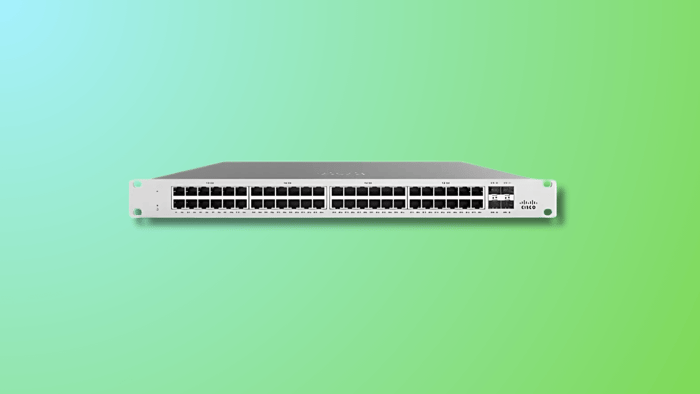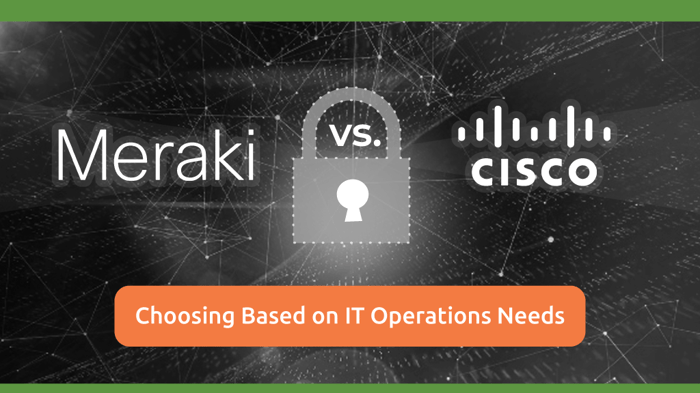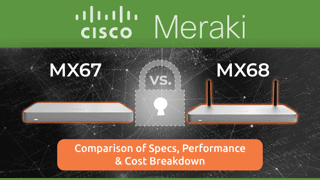Meraki Vs Fortinet: A Comprehensive Comparison
Table of Contents
- Comparing Key Features of Meraki vs Fortinet
- Network Management and Deployment
- Automation, Control, and Extensibility
- Security and Reporting Capabilities
- Suitability for Different Industries
- Pricing and Licensing Comparison
- User Experience and Support Satisfaction
- Which Network Platform Is Right for You?
- Let Us Help You Make the Right Network Choice
- FAQs
Picking a firewall shouldn’t feel like guesswork. Cisco Meraki vs Fortinet both promise strong security, but they solve the problem in very different ways: one with a cloud-first dashboard, the other with deep, hands-on control.
This guide measures what matters: setup time, automation options, threat coverage, and long-term costs. Use the info here to match each platform to your team, compliance list, and growth plans.
Comparing Key Features of Meraki vs Fortinet
Before diving into deeper topics like automation and threat defense, let’s line up the head‑to‑head specs that matter most. The table below highlights where each platform shines and where it falls short, setting the stage for the detailed sections that follow.
Feature | Meraki | Fortinet |
Management Architecture | 100 % cloud‑managed dashboard (no servers to babysit) | Hybrid: local GUI/CLI, on‑box management, optional FortiManager/FortiCloud |
Automation & Integration Stack | Template‑driven provisioning, lightweight APIs, native Cisco ecosystem hooks | Deep REST & Terraform libraries, Ansible collections, rich event hooks |
Threat‑Prevention Capabilities | Full NGFW, IPS, AMP, and DNS security delivered from the cloud | ASIC‑accelerated NGFW, IPS, SSL decryption, CASB, and OT security bundles |
Typical Use Case | Lean IT teams that value speed, visibility, and “it just works” rollouts | Security‑heavy orgs that need granular knobs, advanced segmentation, and custom stacks |
Licensing & Scalability | Simple subscription tiers—one license per device, all features | Perpetual + support or term bundles; à‑la‑carte services; pay‑as‑you‑grow models |
Admin UX & Support | Single‑pane HTML5 dashboard, mobile app, built‑in guided flows | CLI power, full‑feature GUI, FortiCare premium tiers, vendor/vendor‑neutral training |
The biggest gaps boil down to management style, automation depth, and security horsepower, three levers that matter more than raw throughput on most modern networks.
Network Management and Deployment
A firewall is only as effective as the tools you use to set it up and maintain it. This section examines how each vendor handles day-zero installations and day-two changes, then focuses on the pros and cons of their management models.
Management Architecture: Meraki vs Fortinet
Meraki: Every box phones home to the Meraki cloud. You drive policy, monitoring, and firmware from a single dashboard—no patch roulette or controller sprawl.
Fortinet: Runs fine as a standalone appliance, but most admins pair FortiGate units with FortiManager or FortiCloud for fleet control. Flexibility is great, yet you’ll juggle more moving parts.
Deployment Efficiency
Rolling out dozens of sites on a tight timeline? The setup story can make or break a project.
Meraki’s plug‑and‑play model: Ship an MX, plug in the WAN and power, and it auto‑configures in minutes. Ideal when two hands must cover twenty branches.
Fortinet’s granular rollout: Zero‑touch is possible, but many teams pre‑stage with scripts or FortiDeploy to nail every policy. Slower upfront, yet delivers surgical control for complex topologies.
Automation, Control, and Extensibility
Once the hardware is online, the real work starts—integrating with your toolchain, automating changes, and scaling configs. Here’s where the two vendors take noticeably different paths.
Policy Automation and Zero‑Touch Provisioning
Meraki relies on configuration templates and network cloning, making it ideal for SMB and mid-market businesses. Fortinet brings full REST APIs, Terraform modules, and scriptable rule bases. If your ops team lives in Git and pipelines, Fortinet feels like home.
API Access and Scripting Capabilities
Meraki: Clean, well‑documented endpoints, but the scope skews toward monitoring and basic pushes.
Fortinet: Broad object model—firewall rules, SD‑WAN paths, SD‑Branch, and more—ready for CI/CD playbooks.
Third‑Party Integration and Mobile Admin Experience
Meraki’s marketplace offers one‑click tie‑ins for MDM, guest Wi‑Fi, and analytics. Fortinet matches that depth on the security side: SIEM feeds, OT gateways, and public‑cloud fabric connectors. Both ship mobile apps; Meraki’s favors snapshot health, while Fortinet’s adds packet capture and CLI for on‑the‑go troubleshooting.
Security and Reporting Capabilities
Performance is pointless if the box can’t block threats or prove compliance. Let’s walk through detection power, logging depth, and how each platform keeps auditors off your back.
Threat Detection and Prevention Stack
Meraki funnels traffic through Cisco Talos intelligence for NGFW, IDS/IPS, and DNS‑layer defense. Fortinet wields custom ASICs, meaning decryption and threat inspection happen at wire speed. If your compliance team demands SSL deep‑packet inspection on 10 Gb links, Fortinet wins on horsepower.
Visibility and Custom Reporting
Logs and dashboards mean nothing if you can’t find answers fast. Here’s how each vendor surfaces data for audits and day‑to‑day troubleshooting.
Meraki: Polished dashboards, auto‑generated weekly reports, and lifetime usage charts—no log server required.
Fortinet: Raw log depth out of the box. Pipe events to FortiAnalyzer or Splunk for multi‑year forensics and custom SIEM dashboards.
Suitability for Different Industries
Every vertical faces its own mix of budget limits, compliance headaches, and staffing realities. The quick lists below flag where each vendor’s strengths line up with real‑world needs.
Industries That Benefit from Meraki
Meraki shines for teams that need quick setups, lean administration, and customer‑facing Wi‑Fi they can trust.
Retail & quick‑serve: Rapid store turns, POS segmentation, and guest Wi‑Fi analytics
Education: Classroom content filtering, 1:1 device rollouts, and e‑rate reporting
Hospitality: Simple SSID splash pages, location analytics, and low‑touch upgrades
Lean IT SMBs & nonprofits: One admin, many hats, visibility beats endless CLI sessions
Industries That Benefit from Fortinet
Fortinet fits sectors with strict compliance rules, heavy encrypted traffic, and security crews who want every tuning knob.
Healthcare: HIPAA‑minded packet logging, micro‑segmentation for IoT, secure SD‑WAN
Finance & banking: Low‑latency inspection, multi‑factor admin hardening, audit‑grade logs
Government & utilities: FIPS‑validated crypto and policy‑based routing at scale
Enterprise IT: Mix‑and‑match FortiGate, FortiSwitch, and FortiAP for full fabric security
Pricing and Licensing Comparison
Costs rarely follow a straight line, so understanding each vendor’s model up front prevents renewal sticker shock.
Meraki asks one question: “Which tier?” Choose Enterprise or Advanced Security, then buy a co-terminus subscription that covers hardware, features, and support. Forecasting is painless, but true‑ups are all‑or‑nothing.
Fortinet offers perpetual licenses with annual support or term bundles that bolt on extra services, Web Filter, CASB, and OT security. You can stagger renewals or strip services you don’t need. Complexity goes up, yet large enterprises often save when they already own FortiManager or analytics seats.
User Experience and Support Satisfaction
Hardware specs don’t tell the whole story, so we checked the review boards and customer calls to see how admins actually feel.
Meraki fans praise the polished UI, guided wizards, and short learning curves. Common gripe: fewer low‑level knobs for niche scenarios.
Fortinet devotees love the sprawling feature set, aggressive firmware cadence, and global FortiCare tiers. Complaint: The first month feels like CCNA boot camp.
Either way, both vendors land in Gartner’s upper right for customer satisfaction, proving that support ecosystems can make or break a platform.
Which Network Platform Is Right for You?
Ask yourself three questions:
How lean is my team? One or two admins across dozens of branches? Meraki’s cloud model keeps nights and weekends quiet.
How deep is my security stack? If you need high‑speed content inspection, custom segmentation, and API‑driven workflows, Fortinet’s fabric is hard to beat.
What’s our appetite for complexity? Meraki’s predictability eliminates surprises. Fortinet lets you design exactly what you want—just expect a steeper climb.
Meraki keeps life simple: quick installs, one license, and a dashboard anyone can read. Fortinet hands power users every dial they could want, plus the horsepower for heavy SSL inspection and custom automation.
Line those strengths up against your staff size and security goals. If you’re still unsure, run both in a pilot, watch the logs, and follow the data. The right choice is the one that lets your network stay fast, and your admins stay sane.
Let Us Help You Make the Right Network Choice
Choosing a firewall shouldn’t feel like a gamble. Our engineers can spin up a sandbox, compare license models, and map rollout timelines, often in a single call. When you’re ready, we’ll handle the paperwork and keep the project moving at your pace.
Looking for a seamless, cloud-managed network solution? Explore how Meraki can enhance your network's security, scalability, and ease of management.
FAQs
Does Meraki or Fortinet deploy faster?
Meraki wins on deployment speed. Devices are zero-touch, auto-configure through the cloud, and can be rolled out in minutes. Fortinet deployments are more manual, but they offer tighter control over every policy—better for complex enterprise topologies.
What industries benefit most from Meraki?
Meraki shines in retail, education, hospitality, and SMBs, where speed, cloud-based visibility, and low-touch IT are critical.





